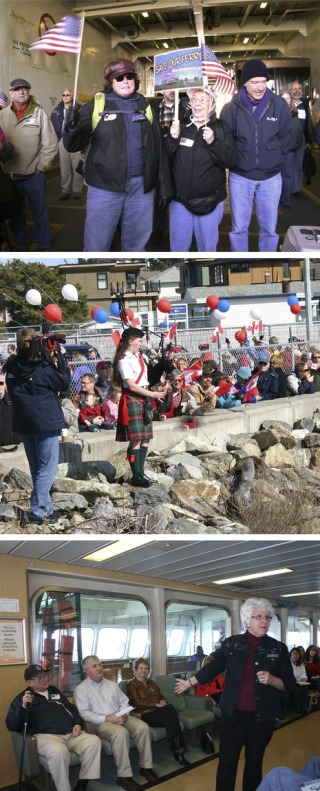By RICHARD WALKER
JOURNAL OF THE SAN JUANS EDITOR
The sun shone in a clear sky, Canadians waved U.S. flags and a bagpiper piped a welcome as about 225 mainlanders and islanders walked off the ferry and onto Canadian soil in Sidney, B.C.
The first Anacortes-San Juan Islands-Sidney ferry run of the season was celebrated on both sides of the international border Sunday. But those riding this ferry knew that the event was as much a campaign as a party, particularly with talk in Olympia of possibly ending the route in the future.
Washington State Ferries claims that eliminating the ferry run would reduce its debt load by $9.4 million over a number of years. But local officials said Sunday they believe the ferry run could be profitable rather than a financial drain, and they and state officials shared ideas on how to make it so.
Anacortes Mayor Dean Maxwell said that until 1998, only one other ferry route — the heavily traveled link between Seattle and Bainbridge Island covered a higher proportion of its expenses than the Anacortes-San Juan Islands-Sidney run.
He said the route could bring in more fares if a larger vessel were kept on the route and if service were offered year-round. He compared seasonal service to a “bus that stops in front of your house at 1 p.m. and 5 p.m., but it doesn’t come the next day.”
Ed Sutton, chairman of the San Juan County Ferry Advisory Committee, shared statistics that show the Anacortes-San Juan Islands ferry covers 44 percent of its annual expenses with fares, known in transportation parlance as “farebox recovery.” The Sidney run recovers 54.8 percent of its expenses at the farebox. The state subsidizes the rest.
But Sutton said the system is spending more money than it needs to. He believes the schedules in the San Juans could be more efficient; too many late ferries run with too many empty vehicle spaces.
Top legislative leaders talked about how they can keep the Sidney run afloat as well as meet Washington’s other transportation needs.
State Rep. Judy Clibborn, D-Mercer Island, chairwoman of the House Transportation Committee, wants to restrict the costs of ferry terminal reconstruction and better maintain the ferries currently in service. And four new vessels are planned, with the first being completed by August 2010.
To increase revenue, the Legislature may increase the gas tax and resurrect annual vehicle license fees based on the value of each vehicle. A 5-cent-per-gallon increase would reportedly raise more than $400 million every two years.
Washington is currently ranked seventh of 50 states with a fuel tax of 37.60 cents per gallon; of those top seven states, Washington is the only one that doesn’t collect a state income tax.
House Speaker Pro Tem Jeff Morris, D-Anacortes, doubts the state would save money by eliminating the Sidney run. Earlier this year, he opposed Gov. Gregoire’s plans to spend $11.7 million on an Enhanced Driver License program which would allow vetted Americans and Canadians more efficient border crossings, and a proposed ferry ticket reservation system which would cost $12 million to implement.
Morris also questioned the cost of past system upgrades. Improvements to the Sidney ferry landing cost $2.5 million; rebuilding the Shaw Island ferry landing, by comparison, cost $10 million, Morris said.
Morris said the hull design of proposed new state ferries would be more fuel efficient, and the state would see a savings there. New safety designs could require fewer crew members.
Elected officials weren’t the only ones with ideas about how to make the system profitable. Some passengers in the Friday Harbor ferry terminal were surprised to learn that senior citizens walking onto the Sidney ferry could ride for only $3. Walk-ons ride the interisland ferry for free; some passengers said they wouldn’t mind paying a fair rate for the service.
Others said cutting the ferry route would be damaging to the region’s economy. In a letter read by Morris, Sen. Kevin Ranker, D-San Juan Island, said eliminating the Sidney run would be “foolhardy,” especially with the 2010 Olympics on the horizon.
According to a study by E.D. Hovee and Company: In 2006, about 131,600 passengers rode the ferry between Anacortes and Sidney. About 1,470 jobs with more than $30 million in annual payroll and nearly $126 million in annual spending are directly and indirectly associated with this ferry service within the Northern Puget Sound region. The state receives $4.6 million a year in taxes related to the ferry run. And local jurisdictions collect $1.3 million in tax receipts annually.
A display of photographs illustrated the importance of the ferry route to Coast Salish people who comprise several indigenous nations in Washington state and Vancouver Island. Coast Salish people use the ferry to visit family and participate in ceremonial gatherings on both sides of the border. And during the 2008 Canoe Journey, about 500 canoe family members, 60 vehicles and 22 trailers took the ferry to the San Juan Islands and then to Sidney.
Coast Salish leaders said eliminating the ferry run would force travelers bound for Vancouver Island to drive 85 miles north to Tsawassen, in lower mainland British Columbia, and take a B.C. ferry to Vancouver Island.
Natasha James, 14, and Lewis James, 12, rode the ferry to Sidney with their grandmother, Rosie Cayou-James, of the Samish Indian Nation. The children have relatives at Samish and Swinomish on the U.S. side of the border, and at Tseycum First Nation in North Saanich, where they live.
“This ferry is the only way the grandkids can get there because their parents work,” Cayou-James said. “I have five grandkids on Vancouver Island. Without this ferry, grandma has no way to visit the grandchildren.”



